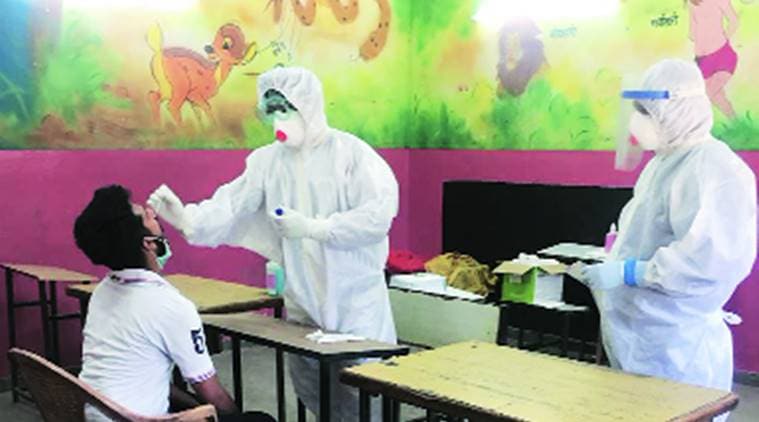 Raj Kumar at work at Bapu Dham Colony, Chandigarh. (Express photo)
Raj Kumar at work at Bapu Dham Colony, Chandigarh. (Express photo)
On the first day the health department began sampling residents inside a school at the Covid-19 hotspot of Bapu Dham Colony, two healthcare workers passed out due to acute dehydration. “Our staffers faint regularly due to heat and dehydration, some even began vomiting. One attendant had to be placed on a drip for an hour before they recovered. It is a tough job, but our staff is doing it regardless,” says an official from the health department.
The experience of wearing a PPE kit is uncomfortable inside a cool hospital room. However, under the current heatwave, it is an excruciating experience for healthcare workers — each minute inside plastic suit is intolerable. “You start sweating as soon as you don the suit, and within five minutes you are drenched in sweat. It appears as if you just took a shower. That’s how much moisture you lose,” says Raj Kumar, an attendant from GMSH-16 posted on duty to collect samples inside the government school.
Teams consisting of resident doctors, nurses, attendants and lab technicians deputed by GMSH-16 and GMCH-32 have been tasked with collecting samples inside a government school at Bapu Dham Colony, from where 210 residents have already been diagnosed with Covid-19. The team from GMSH-16 works a shift between 9 am and 11 am every day, collecting an average of 60 samples a day, while the team from GMCH-32 collects the rest of the samples. “We can’t last in that suit in this heat for more than one and a half hours anyway. On some days, not even more than half an hour,” Kumar adds.
The sampling centre is set up inside a classroom of the government school. As part of containment measures, the windows are sealed shut with the sunlight pouring in from three directions, and no fans or any form of air-conditioning can be used. “There can be no circulation of air. Our entry and exit points are controlled. Nothing should escape the classroom,” says Kumar. Residents enter from door and exit from another while another exit way leads to doffing area for the healthcare workers.
For Kumar, the only way to get through his duty hours in the sealed and multilayered plastic suit is to remain focused on the mechanical job of collecting swabs from patients and sealing them in tube. “As long as the patients keep coming and I focus on the very mechanical job at hand, I keep working like a robot. Once there is a delay, the feeling of breathlessness and nausea overwhelms you and you can no longer sit there in that suit,” Kumar says. The healthcare worker can only drink about a glass of water before donning his suit as he cannot use the toilet in between his duty hours. So not only are the staffers getting dehydrated due to excessive sweating, but also they are thirsty to begin with. “Sometimes you are so nauseous after you finish, it’s hard to drink a lot of water in one go, even though your body needs it,” Kumar adds.
Even the job at hand, which keeps him going, i.e. taking swabs and storing them properly before they are transported for testing at PGIMER, is an arduous task, not as easy and mechanical as Kumar makes it seem. “After a while your glasses are fogged and you can’t even see the patients lined ahead of you,” Kumar says. After taking nasal and throat swabs from the residents, Kumar places them in a Viral Transportation Medium inside a tube, which is then sealed by a tape, wrapped in a plastic layer and then another layer before being placed in the containment box. “Also between each sample collection, I sanitize my gloves, often even change them,” Kumar explains.